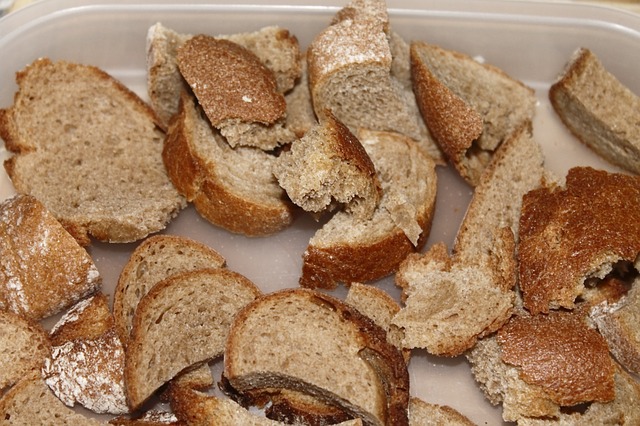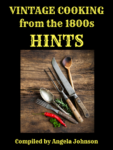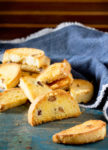
Never Waste Stale Bread
“Never waste stale bread, as it may be used to advantage in many ways. The economical housewife carefully inspects the contents of her bread box every morning before planning her meals for the day.”
INFORMATION BELOW FROM 1800s COOKBOOKS
SAVORY FRIED BREAD
Cut slices of stale home-made bread about half an inch thick. Soak the slices in a rich, well seasoned vegetable stock until nearly saturated with it, but don’t allow them to become too soft. Then dip them in beaten egg mixed with a little milk. Fry in butter in a spider* until a nice brown. Serve with tomato sauce, or around a dish of stewed tomatoes.
*spider – a skillet with a flat bottom, straight shallow sides, a short handle and three short legs.
EGG BREAD
Fry a half dozen slices of thinly-sliced bacon in a pan. Put bacon, when fried, in the oven to keep hot. Cut stale bread into slices about three-fourths inch thick and then cut each in half horizontally.
Make the following mixture: one pint of *sweet milk, three eggs, one teaspoon flour mixed smooth with a little of the cold milk, and a pinch of salt.
Place the bread pieces into the mixture and soak for a few minutes, turning frequently. Dip the slices of soaked bread in fine, dried bread crumbs and fry quickly in the bacon fat (to which has been added one tablespoon of butter) to a golden brown. Serve at once on the same platter with the bacon. This is an appetizing and wholesome breakfast or luncheon dish, served with a tart jelly, either currant or grape.
*sweet milk – whole milk; it was called sweet milk to distinguish it from buttermilk.
CINNAMON TOAST
Cut stale bread into thin slices, remove crusts, and cut in halves. Toast evenly and spread first with butter, then with honey, and dust with cinnamon. Serve very hot.
CELERY TOAST
Cook two cups of celery cut in half-inch pieces in three cups stock or water about half an hour, or until tender. Add salt (if necessary), pepper, and one-third cup flour mixed to a paste with one-fourth cup milk. Stir until thickened, and simmer fifteen minutes. Pour over toast, and garnish with parsley.
WHITE BREAD GRIDDLE CAKES
Chop as much stale bread as will measure two cupfuls. Put it into a bowl and pour over it a cup of sweet, rich milk and let it soak for an hour. When ready to bake the cakes, mash the bread in the milk with a wooden spoon, add a heaping teaspoon of sugar, a teaspoon of salt, two tablespoons of melted butter, and two well-beaten eggs. Sift into this mixture a cup of white flour and an even teaspoon of soda. Stir well together, then add a cup of sour milk and bake on a griddle.
BREAD PUDDING
Boil one quart of milk with three sticks of cinnamon, slightly broken. Strain it and set it away till quite cold. Grate as much crumb of stale bread as will weigh a quarter of a pound. Beat eight eggs and add it to the cold milk. Add the bread crumbs and one-fourth pound of sugar, stirring well, then add a little grated lemon-peel. Bake the pudding it in a buttered dish, and grate nutmeg over it when done. Do not send it to table hot. Baked puddings should never be eaten till they have become cold, or at least cool.
NOTE: This 1800s recipe above had no oven temperature or cooking time. According to a bread pudding recipe on the Allrecipes website, it should be cooked at 350 degrees Farenheit for 45 minutes.
MORE USES FOR STALE BREAD AND CRUMBS
— Cut stale bread into small pieces, the size of dice. Brown in a hot oven (about 400-450 degrees Fahrenheit) and serve with soup instead of serving crackers.
— Small pieces of bread that cannot be used otherwise should be spread over a large pan, placed in a moderate oven [about 350-400 degrees Fahrenheit] and dried until crisp. They may then be easily rolled fine with a rolling-pin or run through the food chopper and then sifted. Put in a jar, but not in an air-tight jar. Tie a piece of cheese-cloth over the top of the jar and keep in a dry place until wanted.
— Crackers and dry bread, when being ground, result in considerable muss and loss of crumbs. Eliminate both by fastening a paper sack over the mouth of the grinder with a rubber band.
— Stale scraps of bread should be put in a tin in the oven and baked a nice brown. When quite crisp, they should be pounded and bottled. They are invaluable for many dishes and it saves time to keep them ready. They will keep a long time in a dry place.
— The corn popper can be used for toasting odds and ends of stale bread which would otherwise be wasted.
— Bread, cracker or zwieback crumbs, corn meal, flour or browned flour, or a mixture of crumbs and brown or white flour may be used for rolling croquettes or cutlets, or for sprinkling the top of scallops or gratins.
— Crumbs may be used for crumbing eggplant, oysters, veal cutlets or croquettes. All should be dipped in beaten white of eggs and then in the crumbs, seasoned with salt and pepper, then floated in a pan of hot fat composed of two-third lard and one-third suet. All except veal cutlets. They should be crumbed, not floated in deep fat, but fried slowly in a couple tablespoons of butter and lard.
— When bread crumbs are used for puddings or molds, the quantity will vary with the kind of bread. Fewer will be required with home-made bread than with baker’s bread.
— Crumbs spread over the tops of dishes should be mixed evenly with melted butter over the fire. This is a better method than having lumps of butter dotted over the crumbs after they are spread.
— When the sauce bubbles through the crumbs on top of a scallop dish, the cooking is completed.
=================================================

 Vintage Cooking from the 1800s – HINTS
Vintage Cooking from the 1800s – HINTS
STEP BACK IN TIME to the 1800s …. imagine how difficult it was to prepare and cook food before gas and electricity was available. Advice and cooking hints were sometimes included at the end of cookbooks and greatly appreciated.
Hints include:
- keeping milk sweet
- keeping weevils out of wheat
- keeping meats, fish and poultry fresh in hot weather
- removing insects from vegetables being washed
- taking the white of an egg for a sour stomach
- and many, many more….
Available from these online Retailers:
Amazon, Kobo, Apple, Barnes&Noble, Scribd, 24 Symbols, Playster, Angues & Robertson, Mondadori Store, and more
Also available as Regular Print  and Large Print
and Large Print on Amazon.
on Amazon.
=================================================

7 thoughts on “Never Waste Stale Bread”
idk im still gonna waste it im not eating moldy bread 🤢
They cut the molded part off the bread before they ate the rest. Back in those days, food was precious. Today we can refrigerate or freeze our bread to preserve it. People did have small refrigerators that held a block of ice to keep their food cold, but they weren’t going to waste the small space for bread!
I’m sure glad we have modern conveniences.
I used to cut stale bread into squares and make a kind of scrambled French toast out of it back in the day when I still ate bread. Sure sounds good now though. I haven’t eaten since lunch. 🙂
I still eat bread, although not as much as I used to.
wait, u eat MOLDY bread, lol so sorry i have the same last name as you, we so coollll rnnnnnn
My mother used to use up stale bread in what we called ‘bread and butter pudding’ which I think is pretty much the same as the bread pudding you describe here except that the bread wasn’t grated it was broken into small pieces or even left as whole or half slices. She also used to add currants or sultanas.
My mother never did make bread pudding, although I have tried it as an adult. When we had stale bread, we toasted it in a toaster and put butter on it. If the bread was in small pieces, we fed it to the birds.